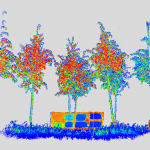Geospatial Engineering researchers recently took a trip ‘Down Under’ to participate in a unique terrestrial laser scanning inter-comparison exercise. Dr Rachel Gaulton and Dr Steve Hancock joined almost 30 leading researchers from the UK, Australia and the U.S. at field sites near Brisbane in early August to evaluate and compare how five different laser scanners and a range of other measurement approaches can help to measure and monitor forest canopy structure. These scanners included the Salford Advanced Laser Canopy Analyser (or SALCA) , the subject of on-going NERC-funded research at Newcastle, in collaboration with University of Salford and UCL, examining the potential of dual-wavelength laser scanning for assessing forest canopy health.
The exercise, organised by John Armston and colleagues at DSITIA Queensland and CSIRO, was an activity of the Terrestrial Laser Scanning International Interest Group (TLSIIG), a recently formed network of scientists with an interest in forest laser scanning. Alongside SALCA, measurements of three field plots were made with the World’s only other dual-wavelength TLS, DWEL (developed by Prof. Alan Strahler at Boston University with collaborators at CSIRO, UMass Boston and UMass Lowell), the low-cost Canopy Biomass Lidars (named Candi and Bruno and developed by UMass Boston and RIT) and two commercial systems. Photogrammetric techniques also played a part with co-incident measurements made with the AusPlots ‘Photopoint’ method, a system designed to obtain 3D forest structure information from photo panoramas. A report on the exercise featured on Australian TV News .

Alongside the high-tech methods, leaf samples from the tree canopies were needed to allow measurement of spectral properties and to test the ability of dual-wavelength data to distinguish leaves and bark – a key factor in producing accurate estimates of canopy structure. Steve joined the destructive sampling team in using a ‘line thrower’ (or big slingshot) to collect the samples and undertook additional sampling to estimate the true leaf area index of a section of heavily laser scanned tree canopy. Work is now on-going to calibrate and compare the data sets, with early results presented by TLSIIG members (John Armston, Crystal Schaaf and Alan Strahler) at the Silvilaser 2013 conference in Beijing.
 |
 |
| Ian Paynter (UMass) and Steve with canopy samples and the line thrower (left) and a subset of SALCA data from Brisbane Forest Park (right). | |
The work in Brisbane followed a month-long field experiment with the SALCA instrument at the University’s Cockle Park Farm. The experiment, part of a NERC-funded research project examining the potential of dual-wavelength laser scanning in forest health monitoring, was focussed on testing the sensitivity of the instrument to changes in canopy water content – an indicator of drought or disease. The canopy-scale experiment at Cockle Park involved subjecting 22 trees to drought stress, whilst making extensive physiological, spectral and laser scanner measurements and preliminary results have recently been presented by Rachel at the RSPSoc 2013 Annual Conference in Glasgow and the 9th EARSeL Forest Fire Special Interest Group Workshop held in Warwickshire.
More information about the SALCA instrument and on-going research can be found in the SALCA Diaries.
 |
 |
| Scanning small-leaved lime at Cockle Park farm and SALCA data from a group of trees suffering drought stress (colours indicate reflectance at 1545 nm). | |
Many thanks are due to John Armston and colleagues for their hard work organising the Brisbane field work. Steve Hancock’s travel to the inter-comparison exercise was funded by a small grant from the Douglas Bomford Trust.
